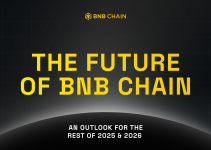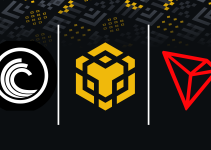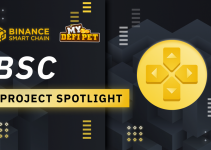“In this article, I will try to explain a few basic concepts in relation to token economics. It should be pretty light reading.” – CZ, Binance CEO.
Every day I see people with flawed thinking in regards to a few basic concepts in relation to token economics. I understand that a lot of things about finance, including how money supplies work, aren’t taught in school. I also understand that the crypto industry is new, and there are some things we all need to learn.
In this article, I will try to explain some of these concepts. It should be pretty light reading. These are just my personal opinions and, as with any opinion, could very well be wrong in some or all places. I also encourage everyone to read more about token economics and other related topics on Binance Academy.
The Buckets of Money Thinking Fallacy
This thinking fallacy manifests itself in many ways.
A common version we hear all the time is “I don’t want to spend BTC (or BNB)” because it will appreciate in value faster and I don’t want to lose out on the gains, so I will just spend fiat to buy things.”
Well, why don’t you just convert a bit more of your fiat (at least the part you will spend) into crypto, and then you can spend crypto with ease. You can move your money between buckets.
Some may argue that there is a conversion fee involved. It’s really quite low these days. Binance.com charges about 0.03%, and when compared to the 3% that credit cards charge, our rate is 1/100 of theirs. (Sorry, I had to work this bit of advertising in there.)
Others may argue it’s still not too convenient to spend crypto, and that’s fair and a valid reason. We are working on improving that. But that’s a different reason from “I don’t want to spend BTC because it may rise in value faster.”
Where Are You Burning From?
Another recent version of this logical fallacy starts with the question of “where are you burning from?”
We burned $60.5M USD worth of BNB yesterday. Still some people, including some otherwise-intelligent reporters, were asking “did you burn the BNB from revenue or was it from the team portion?” like there is a difference between the two. Both result in deflationary pressure.
There is no foundation managing BNB. We allocated a portion of the BNB during the ICO stage to be the “team portion,” made fully transparent from day 0. This portion unlocks yearly over 5 years. Given we are 3 years in, a portion of the team tokens has been unlocked. Our team can spend it, if we wish. The fact that we haven’t spent much of it is just our choice. More importantly, the team tokens belong to the team, and our earnings also belong to the team. BNB is a fungible token, there is no difference between one bucket to another. We could put them into the same wallet, same address, or we can keep them on separate addresses, but they all belong to our team. When we do a burn, we sacrifice the BNB we own and reduce the total supply. It makes the rest of the BNB more valuable. Does it matter which wallet address we burned from? If yes, we can move the coin around before the next burn…
Did You Buy It Back From the Market?
This is a slightly more “advanced” version of the same “bucket of money” fallacy. This one is more natural for people coming from the traditional markets. A company’s income is in fiat, and they take a portion of that fiat to convert to/buy back stock. It usually causes the stock price to rise and investors love it. Some people naturally think the same should be done in crypto.
There are some key differences when it comes to Binance’s BNB burn. Binance’s income is already mostly in BNB and we HODL them. We don’t convert them to fiat, other than amounts that we will immediately spend. Now, we could sell our BNB into fiat, and then use that fiat to buy back BNB to do the burn. Does that make sense to do? No.
However, some will argue the above is sensible to do; that we should sell our BNB into fiat throughout the quarter, and buy back the BNB aggressively just before the burn, and this way, there should be a short pump effect just before the burn, and they can trade accordingly. No sorry, we don’t do that. We just hold BNB. We don’t want to hold fiat for any extended period of time. This does reduce the incentives for some short-term traders, but the benefits are much better for long-term BNB hodlers. We also don’t want to be adding artificial incentives that may make BNB a “pump & dump” coin. We want to, together with many of our ecosystem partners, build long-lasting value for BNB and the crypto industry.
Some exchanges even proudly (or shamelessly) promote the fact they do the “buy-backs” for their own exchange tokens before the burn. And some people may unfortunately believe that is a good thing. It would mean:
- They don’t have income in their own exchange token; i.e., people are not using their tokens to pay for fees. Or,
- They don’t hold their own tokens that they receive. They dump them all onto the market.
Do you want to hold an exchange token when the exchange is not willing to hold it themselves? You decide.
Burn vs. Airdrop
If we did a $60.5M USD equivalent airdrop for BNB instead of a burn, I am guessing more people may be happier. But the two are exactly the same financially. Most people still don’t understand the benefits of a burn, but take my word for it, it’s the same as an airdrop. They are both good for you. A burn has less network transactions and less network fees.
While on this topic, quantitative easing is bad for you. It’s the same as taking money out of your bank account and redistributing it to others, usually to people already richer than you. I will just say that much and leave it up to you to believe/research it or not.
Moving onto other topics…
Multiple Coins per Project or Team
I usually view it as a red flag when a team issues multiple tokens. A team’s bandwidth is limited, issuing more tokens isn’t going to suddenly increase their output. If we take this to the extreme, if a team issues 100 different tokens, vs. a team that just issues one token that can be used in all of their platforms/ecosystem, which would you prefer? Having multiple tokens within a project or team creates all sorts of issues of conflict of interest. Which area will the team spend more effort on? How do you balance that? And this is assuming a hard-working team that is trying to build stuff. Some teams just issue token after token, hoping to raise more money from investors, and don’t build anything.
I want to point out that certain projects design multiple tokens from the beginning, one is a governance token and one is a spending token, etc. There are some valid use cases for this. Don’t take my point to the extreme, and I am not trying to attack all projects with more than one token.
This multiple token issue is present in the Binance ecosystem after some mergers and acquisitions. We don’t have a good way to merge tokens yet. We’re still looking for bright ideas in this area.
For the Binance listing process, when a project team has more than one token, we become more suspicious and ask a lot more questions.
Small Circulating Supply
Another red flag is when a token has a very small (single-digit percentage) circulating supply. Let’s use an extreme example again. Say a token only has 1% circulating supply, the rest of the 99% is controlled by the team or a foundation. Say only 20% of the owners of the circulating supply are active traders. If one guy spends $200,000 USD to buy the coin, it will likely push the 1% circulating market cap to $1 million USD and give the coin a total market cap of $100 million USD. It takes just $200,000 USD to create a $100 million USD market cap.
These coins with only a tiny amount of their total supply circulating are also very prone to pump and dump, or other potential “manipulations” on its price. The biggest risk though is when the locked portion gets unlocked and floods into the market, the price will dump significantly, and retail users get hurt. Learn to protect yourself.
Large Team Holdings
By now, this one should be easy to understand. You want to watch out that the “team portion” may come under different names, such as foundation, marketing budget, community growth, or even reserved for mining or other uses that are very much under the team’s control. I want to point out not all foundations, marketing budgets, and the like are bad. If they are well-managed, then it’s fine. But not all projects are well managed.
To be very transparent, BNB has a large team portion as well. We/I had yet to develop a deep understanding of token economics three years ago. We just have one “team portion,” no separate foundation, marketing, community growth, etc. It is all-inclusive. Luckily, our platform became profitable fairly quickly, and we didn’t have to use or sell the team portion at all, even though they are partially unlocked already. I won’t brag much here, but you can judge the risk for yourself. BNB does have a large circulating supply, and probably has a higher individual user count than most other coins. The network address count doesn’t fully reflect that as many of the BNB users hold them on Binance.
Changing Whitepapers
I am generally against material changes to white papers once they are out. In the order of things, abandoning a project is probably the worst. Material changes to a whitepaper will usually result in some people being affected negatively too. I advise all project teams to be very careful about it.
Binance did make a couple of updates to our whitepaper, but none of the changes are material in any way. In January 2019, we changed the wording around “buy-backs” and the association with “20% profits.” This was done based on a third-party legal counsel advice indicating the potential for being misunderstood as a security is higher in certain regions, and it was not accurately describing the fact that we don’t need to “buy-back.” We hold BNB as explained above. We explained this to inquiring reporters and our community back then.
The big concern then was: Are we going to stop burning? Or are we gonna burn less? No. We explained the amount will not change, only the wording describing it in the whitepaper; i.e. no material changes. We also said our actions will speak louder than words.
Since then, we have done 5 successive ATH burns to date. (Note the 8th burn was done when BNB price was near $40 USD, it was higher than burn 7 in USD terms.)
Our actions have spoken louder than words.
I will end this article here. There are many other topics we could discuss, but I will leave that to another time. Thanks for reading and have a nice weekend!
– CZ


